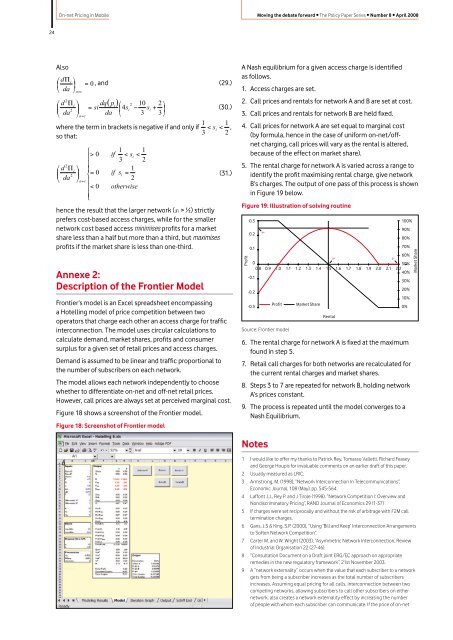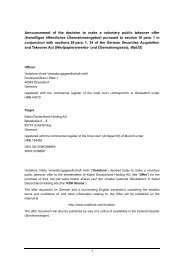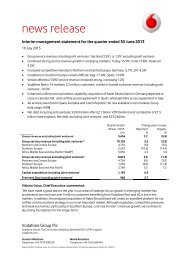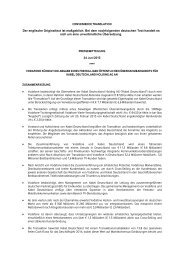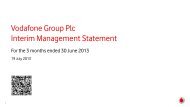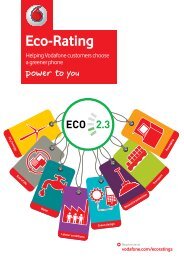Create successful ePaper yourself
Turn your PDF publications into a flip-book with our unique Google optimized e-Paper software.
24<br />
On-net Pricing in Mobile Moving the debate forward • The Policy Paper Series • Number 8 • April 2008<br />
Also<br />
⎛ dΠ<br />
i ⎞<br />
⎜ ⎟<br />
⎝ da ⎠<br />
a=c<br />
= 0<br />
, and (29.)<br />
( p )<br />
⎛ Π ⎞<br />
⎜ ⎟ =<br />
⎝ ⎠ =<br />
⎛ 10 2 ⎞<br />
⎜4<br />
− + ⎟<br />
⎝ 3 3 ⎠<br />
2<br />
2<br />
d i dq i si<br />
2<br />
da<br />
da<br />
a c<br />
si<br />
si<br />
(30.)<br />
1 1<br />
where the term in brackets is negative if and only if < s i < ,<br />
3 2<br />
so that:<br />
2<br />
⎛ d Π ⎞ i ⎜ ⎟ 2<br />
⎝ da ⎠<br />
a=<br />
c<br />
⎧<br />
⎪<br />
> 0<br />
⎪<br />
⎨=<br />
0<br />
⎪<br />
⎪<<br />
0<br />
⎪<br />
⎩<br />
if<br />
1 1<br />
< si<br />
<<br />
3 2<br />
if<br />
1<br />
si<br />
=<br />
2<br />
otherwise<br />
hence the result that the larger network (si > ½) strictly<br />
prefers cost-based access charges, while for the smaller<br />
network cost based access minimises profits for a market<br />
share less than a half but more than a third, but maximises<br />
profits if the market share is less than one-third.<br />
Annexe 2:<br />
Description of the Frontier Model<br />
(31.)<br />
Frontier’s model is an Excel spreadsheet encompassing<br />
a Hotelling model of price competition between two<br />
operators that charge each other an access charge for traffic<br />
interconnection. The model uses circular calculations to<br />
calculate demand, market shares, profits and consumer<br />
surplus for a given set of retail prices and access charges.<br />
Demand is assumed to be linear and traffic proportional to<br />
the number of subscribers on each network.<br />
The model allows each network independently to choose<br />
whether to differentiate on-net and off-net retail prices.<br />
However, call prices are always set at perceived marginal cost.<br />
Figure 18 shows a screenshot of the Frontier model.<br />
Figure 18: Screenshot of Frontier model<br />
A Nash equilibrium for a given access charge is identified<br />
as follows.<br />
1. Access charges are set.<br />
2. Call prices and rentals for network A and B are set at cost.<br />
3. Call prices and rentals for network B are held fixed.<br />
4. Call prices for network A are set equal to marginal cost<br />
(by formula, hence in the case of uniform on-net/offnet<br />
charging, call prices will vary as the rental is altered,<br />
because of the effect on market share).<br />
5. The rental charge for network A is varied across a range to<br />
identify the profit maximising rental charge, give network<br />
B’s charges. The output of one pass of this process is shown<br />
in Figure 19 below.<br />
Figure 19: Illustration of solving routine<br />
Profit<br />
0.3<br />
100%<br />
90%<br />
0.2 P*<br />
0.1<br />
80%<br />
70%<br />
60%<br />
0<br />
R*<br />
S*<br />
50%<br />
0.8 0.9 1.0 1.1 1.2 1.3 1.4 1.5 1.6 1.7 1.8 1.9 2.0 2.1 2.2<br />
40%<br />
-0.1<br />
30%<br />
-0.2<br />
20%<br />
10%<br />
-0.3<br />
Profit Market Share<br />
0%<br />
Source: Frontier model<br />
Rental<br />
6. The rental charge for network A is fixed at the maximum<br />
found in step 5.<br />
7. Retail call charges for both networks are recalculated for<br />
the current rental charges and market shares.<br />
8. Steps 3 to 7 are repeated for network B, holding network<br />
A’s prices constant.<br />
9. The process is repeated until the model converges to a<br />
Nash Equilibrium.<br />
Notes<br />
1 I would like to offer my thanks to Patrick Rey, Tomasso Valletti, Richard Feasey<br />
and George Houpis for invaluable comments on an earlier draft of this paper.<br />
2 Usually measured as LRIC.<br />
3 Armstrong, M. (1998), “Network Interconnection In Telecommunications”,<br />
Economic Journal, 108 (May), pp. 545-564.<br />
4 Laffont J.J., Rey P. and J Tirole (1998), “Network Competition I: Overview and<br />
Nondiscriminatory Pricing”, RAND Journal of Economics 29 (1-37)<br />
5 If charges were set reciprocally and without the risk of arbitrage with F2M call<br />
termination charges.<br />
6 Gans, J.S & King, S.P. (2000), “Using ‘Bill and Keep’ Interconnection Arrangements<br />
to Soften Network Competition”.<br />
7 Carter M. and W. Wright (2003), “Asymmetric Network Interconnection, Review<br />
of Industrial Organisation 22 (27-46).<br />
8 “Consultation Document on a Draft joint ERG/EC approach on appropriate<br />
remedies in the new regulatory framework”, 21st November 2003.<br />
9 A “network externality” occurs when the value that each subscriber to a network<br />
gets from being a subscriber increases as the total number of subscribers<br />
increases. Assuming equal pricing for all calls, interconnection between two<br />
competing networks, allowing subscribers to call other subscribers on either<br />
network, also creates a network externality effect by increasing the number<br />
of people with whom each subscriber can communicate. If the price of on-net<br />
Market Share


